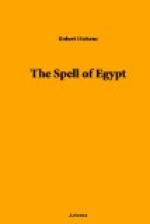From afar one feels their minds, their strange, unearthly temperaments commanding this pastoral. When you are beside them, this feeling disappears. Their features are gone, and though in their attitudes there is power, and there is something that awakens awe, they are more wonderful as a far-off feature of the plain. They gain in grandeur from the night in strangeness from the moonrise, perhaps specially when the Nile comes to their feet. More than three thousand years old, they look less eternal than the Sphinx. Like them, the Sphinx is waiting, but with a greater purpose. The Sphinx reduces man really to nothingness. The Colossi leave him some remnants of individuality. One can conceive of Strabo and AElius Gallus, of Hadrian and Sabina, of others who came over the sunlit land to hear the unearthly song in the dawn, being of some—not much, but still of some—importance here. Before the Sphinx no one is important. But in the distance of the plain the Colossi shed a real magic of calm and solemn personality, and subtly seem to mingle their spirit with the flat, green world, so wide, so still, so fecund, and so peaceful; with the soft airs that are surely scented with an eternal springtime, and with the light that the morning rains down on wheat and clover, on Indian corn and barley, and on brown men laboring, who, perhaps, from the patience of the Colossi in repose have drawn a patience in labor that has in it something not less sublime.
From the Colossi one goes onward toward the trees and the mountains, and very soon one comes to the edge of that strange and fascinating strip of barren land which is strewn with temples and honeycombed with tombs. The sun burns down on it. The heat seems thrown back upon it by the wall of tawny mountains that bounds it on the west. It is dusty, it is arid; it is haunted by swarms of flies, by the guardians of the ruins, and by men and boys trying to sell enormous scarabs and necklaces and amulets, made yesterday, and the day before, in the manufactory of Kurna. From many points it looks not unlike a strangely prolonged rubbish-heap in which busy giants have been digging with huge spades, making mounds and pits, caverns and trenches, piling up here a monstrous heap of stones, casting down there a mighty statue. But how it fascinates! Of curse one knows what it means. One knows that on this strip of land Naville dug out at Deir-el-Bahari the temple of Mentu-hotep, and discovered later, in her shrine, Hathor, the cow-goddess, with the lotus-plants streaming from her sacred forehead to her feet; that long before him Mariette here brought to the light at Drah-abu’l-Neggah the treasures of kings of the twelfth and thirteenth dynasties; that at the foot of those tiger-colored precipices Theodore M. Davis the American found the sepulcher of Queen Hatshepsu, the Queen Elizabeth of the old Egyptian world, and, later, the tomb of Yuaa and Thuaa, the parents of Queen Thiy, containing mummy-cases




